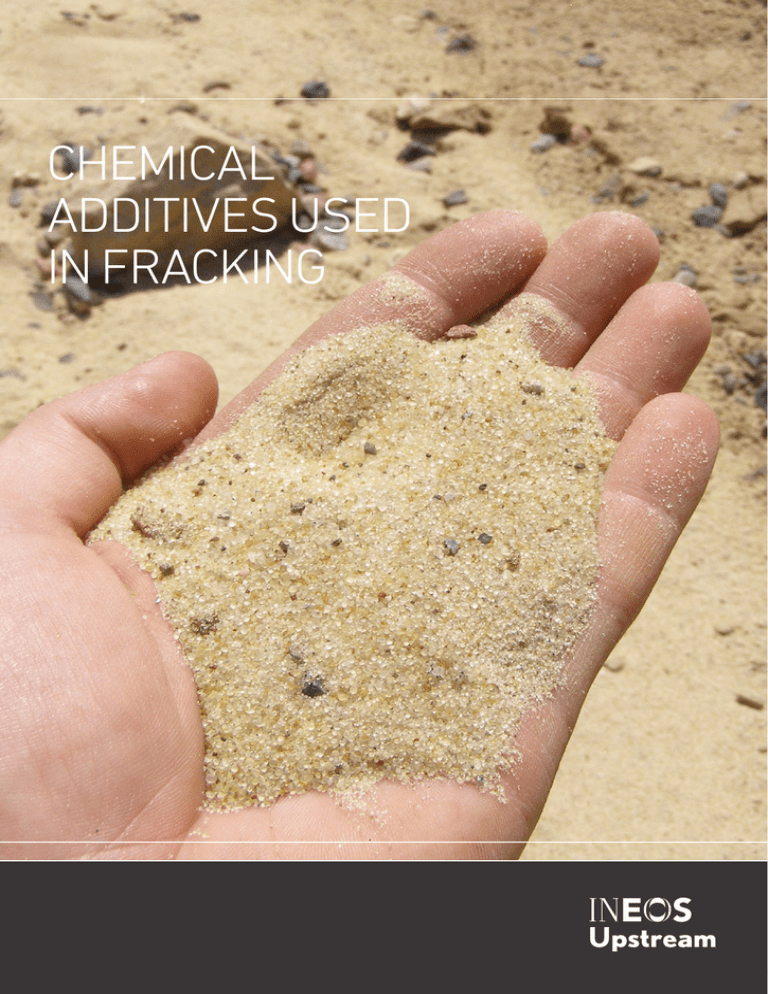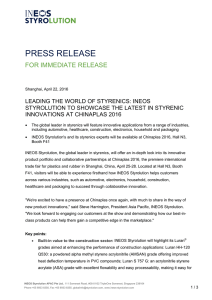chemical additives used in fracking
advertisement

CHEMICAL ADDITIVES USED IN FRACKING CHEMICAL ADDITIVES USED IN FRACKING As one of the worlds largest petrochemical companies, INEOS operates 65 manufacturing sites in 16 different countries. In the UK its sites are strictly Regulated by the Health Safety Executive (HSE), the Environment Agency (EA) and the WATER AND SAND Scottish Environmental Protection Agency (SEPA), FRACKING FLUID IS 99.5% WATER under COMAH (Control Of Major Accidents AND SAND. THE OTHER 0.5% IS Hazards) regulation. The company has a wealth MADE UP OF BASIC ADDITIVES. of expertise in the safe use, handling and storing of chemicals and flammable, pressurised gases. CHEMICAL ADDITIVES Frack fluid is 99.5% water and Our sites operate to the highest environmental sand and does not contain harmful standards backed by sophisticated environmental concentrations of chemicals. Typically fewer than a dozen chemicals are used systems and a strict monitoring and reporting in a given mixture, these are dependent on the specific characteristics of the regime. A clear priority on safety and high rock at each site. All chemical additives have to be disclosed and approved engineering standards means that INEOS brings as safe by the Environment Agency something unique to this emerging industry. or Scottish Environment Protection 99.5% Agency. These additives are designed to improve the safety and performance of the frack, and typically include friction reducers, water purifiers, acids to dissolve minerals, and rust resistors to protect pipes. Many of these are found in higher concentrations in household items, or are used in the purification of our drinking water. All additives together account for less than half of one percent of the fluid. The additives used can include: FRACTURE FLUID CHEMICALS 0.5% Water98% Gellant0.32% Sand1.5% Acid0.044% Chemicals0.5% Corrosion Inhibitor 0.032% Friction reducer 0.032% Clay Control 0.022% Crosslinker0.020% Scale Inhibitor 0.015% Breaker0.013% Iron Control 0.003% Biocide0.0006% Cover photo: Common salt is often used as one of the chemical additives in the fracking process. THE ADDITIVES IN FRACK The additives in frack fluid are AS classified FLUID ARE CLASSIFIED by the Environment Agency as NON-HAZARDOUS nonhazardous in the proportions proposed. KEEP IN CONTACT: WWW.INEOSUPSTREAM.COM TWITTER: @INEOS_UPSTREAM #LETSTALKSHALE GUAR GUM Guar gum is used to thicken the water so that it can carry the sand more effectively. Guar is also used in cooking sauces, toothpaste and ice cream. FRICTION REDUCERS Friction reducers such as polyacrylamide allow the fluid to be pumped at a lower pressure than if water alone was used. Polyacrylamide is also used in water treatment and face creams. BIOCIDES Biocides such as glutaraldehyde are used to prevent bacteria from forming. Glutaraldehyde is also used to sterilise medical and dental equipment. CROSSLINKERS A crosslinker such as borate to maintain consistency of the fluid at temperature. Borate salts are used in soap and cosmetics. HYDROCHLORIC ACID Hydrochloric acid diluted to around 0.03% of the fluid is used to initiate cracks in the rock. Hydrochloric acid is used in food production, cleaning swimming pools, and is created naturally in the stomach. ADJUSTING AGENTS Adjusting agents typically use sodium carbonate to maintain the effectiveness of the other additives. Sodium carbonate is used in soap, water softener, glass and ceramics. BRINE SCALE INHIBITORS Brine, typically produced with potassium chloride. Potassium chloride is a low sodium table salt substitute. Scale inhibitor such as ethylene glycol (0.01% of the fluid) to prevent scale. Ethylene glycol is used in antifreeze. BREAKERS CORROSION INHIBITORS A breaker such as ammonium persulfate is used to maintain the consistency of the fluid. Ammonium persulfate is used in detergent and hair cosmetics. Isopropanol may also be used – this is used in antiperspirant. Corrosion inhibitors to prevent corrosion of the pipes and ensure the well stays sealed. Typically N,n-dimethyl formamide is used – used in pharmaceuticals. Citric acid may be used – used in food flavouring. Ammonium bisulfite – used in cosmetics and beverage production. FURTHER FACTS: n SEPA: www.sepa.org.uk/customer_ information/energy_industry/ unconventional_gas/frequently_asked_ questions.aspx n Office of Unconventional Gas: www.gov.uk/government/groups/ office-of-unconventional-gas-and-oilougo n DECC website: www.gov. uk/government/organisations/ department-of-energy climate-change n UKOOG: www.ukoog.org.uk n Frackland Blog: www.frackland. blogspot.co.uk n No Hot Air: www.nohotair.co.uk/ index.php/library n Refine: www.refine.org.uk n Frac Focus: www.fracfocus.org n The Boom: www.russellgold.net/ books/the-boom n US EPA: www2.epa.gov/ hydraulicfracturing n PENN State University: http://stateimpact.npr.org/ pennsylvania/tag/fracking/ n Range Resources: www.rangeresources.com n CONSOL Energy: www.consolenergy.com INEOS Upstream PO Box 21 Bo’Ness Road Grangemouth Stirlingshire FK3 9XH www.ineosupstream.com twitter: @INEOS_upsteam #letstalkshale email: shale.information@ineos.com

